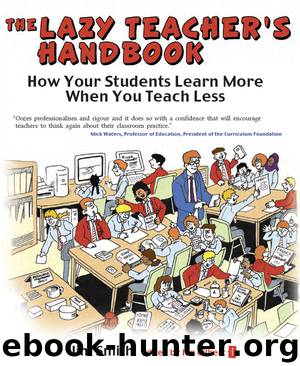The Lazy Teacher's Handbook by Jim Smith

Author:Jim Smith [Jim Smith]
Language: eng
Format: epub
ISBN: 9781845904098
Publisher: Crown House Publishing
RIP marking – getting the planning right
1. Ask yourself key questions
Never set a task without asking yourself the following critical questions:
What will be produced?
How will it be presented?
How can it be assessed?
Who will assess it?
What role will I have to play in this?
What role will the students have in this?
By spending a little more time thinking about the outputs, you will influence what you give as the inputs. Furthermore, my experience has shown me that you will improve the process as well.
2. Plan your focus
Have a focus for your marking and assessment that can be communicated to the students. It goes without saying that people have a greater chance of succeeding if they know what it is they are being measured against. Likewise, ask the students to identify something for you to focus on, such as where they have improved their spelling, presentation or explanation of points. It is very disheartening from their point of view if you do not pick up on their progress.
3. Do it differently – do it the Lazy Way
Choose to do things differently. Whilst some of the ideas take time to set up, you will save time in the long run as you will be able to repeat the formula with different classes. These ideas are an entirely red pen-free zone – which might just be why they go down so well with the students.
Could student work be assessed through a voting system at lunchtime, for example, as an art gallery or poetry performance on the stage? If you have the technology, you could use electronic voting pads. If not, use paper voting cards that can be dropped into a ballot box.
Use school events such as parents’ evenings, careers conventions, school plays or academic mentoring days to show off what work the students have been completing and invite feedback and comments. Similarly, could you create an exhibition of work at a library assessed by the general public? Each piece of work could be rotated to the ‘Comments on this one please’ position on the display board to make sure there is coverage. Student displays should be a demonstration of students’ work remember, not your ability to mark it.
Could you have a ‘guest marker’ such as your link governor, the mayor or the local history group? These people often thrive in getting involved with educational projects (and feeling important).
You could post YouTube movies on the internet and use comments taken from this global population (with a subsequent lesson on e-etiquette probably a must!). This gives a chance for students, parents and colleagues to share in what you have been doing.
You can create a whole range of different assessment criteria if, for example, you film a group’s presentation then play it back to allow more considered evaluations on score cards. It has always amazed me how challenging this is for groups to do, yet they always enjoy doing it. Furthermore, you do not even have to say anything, but the next time you film them, the students certainly do not make the same mistakes again.
Download
This site does not store any files on its server. We only index and link to content provided by other sites. Please contact the content providers to delete copyright contents if any and email us, we'll remove relevant links or contents immediately.
The Art of Coaching Workbook by Elena Aguilar(51000)
Trainspotting by Irvine Welsh(21521)
Twilight of the Idols With the Antichrist and Ecce Homo by Friedrich Nietzsche(18508)
Fangirl by Rainbow Rowell(9104)
Periodization Training for Sports by Tudor Bompa(8173)
Change Your Questions, Change Your Life by Marilee Adams(7638)
This Is How You Lose Her by Junot Diaz(6800)
Asking the Right Questions: A Guide to Critical Thinking by M. Neil Browne & Stuart M. Keeley(5651)
Grit by Angela Duckworth(5525)
Red Sparrow by Jason Matthews(5392)
Paper Towns by Green John(5092)
Room 212 by Kate Stewart(5041)
Ken Follett - World without end by Ken Follett(4647)
Housekeeping by Marilynne Robinson(4349)
The Sports Rules Book by Human Kinetics(4299)
Double Down (Diary of a Wimpy Kid Book 11) by Jeff Kinney(4208)
Papillon (English) by Henri Charrière(4199)
The Motorcycle Diaries by Ernesto Che Guevara(4018)
Exercise Technique Manual for Resistance Training by National Strength & Conditioning Association(3959)
